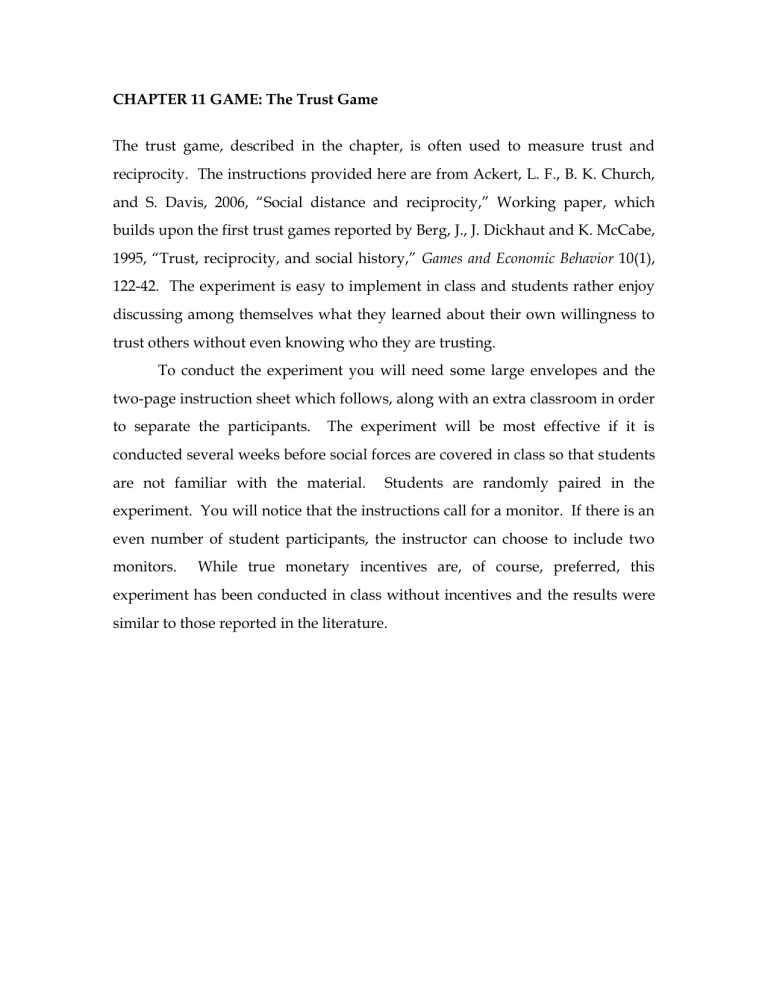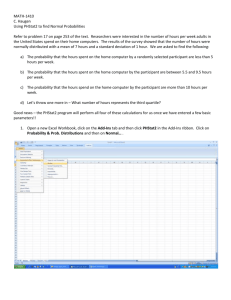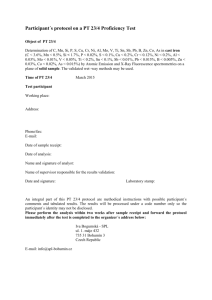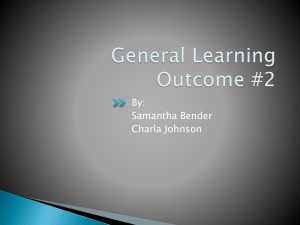CHAPTER 1: FINANCE THEORY

CHAPTER 11 GAME: The Trust Game
The trust game, described in the chapter, is often used to measure trust and reciprocity. The instructions provided here are from Ackert, L. F., B. K. Church, and S. Davis, 2006, “Social distance and reciprocity,” Working paper, which builds upon the first trust games reported by Berg, J., J. Dickhaut and K. McCabe,
1995, “Trust, reciprocity, and social history,” Games and Economic Behavior 10(1),
122-42. The experiment is easy to implement in class and students rather enjoy discussing among themselves what they learned about their own willingness to trust others without even knowing who they are trusting.
To conduct the experiment you will need some large envelopes and the two-page instruction sheet which follows, along with an extra classroom in order to separate the participants. The experiment will be most effective if it is conducted several weeks before social forces are covered in class so that students are not familiar with the material. Students are randomly paired in the experiment. You will notice that the instructions call for a monitor. If there is an even number of student participants, the instructor can choose to include two monitors. While true monetary incentives are, of course, preferred, this experiment has been conducted in class without incentives and the results were similar to those reported in the literature.
2 | P a g e
STUDENT INSTRUCTIONS
You have been asked to participate in a decision-making experiment. In the experiment, you will be paired with another participant located in another room.
You will not be told the identity of the other participant at any time during or after the experiment. It is very important that you not talk or communicate with others throughout the experiment.
One half of the participants are completing the experiment in Room A and the other half in Room B. Each participant in Room A will be randomly paired with someone in Room B. Each participant in Room A and Room B is given $10.
Participants in Room A have the opportunity to send any portion of their $10 to a randomly assigned participant in Room B. Participants in Room A can send any dollar amount – $0, $1, $2, $3, $4, $5, $6, $7, $8, $9, or $10.
Each dollar sent to Room B is increased three times. Participants in Room B decide how much money to send back to Room A and how much money to keep.
Participants in Room B can send back any dollar amount – ranging from $0 to three-times the amount received from Room A.
The remainder of the instructions explains exactly how the experiment is conducted. The experiment is structured so that no one, including the experimenters, will know the personal decisions of participants in Room A or
Room B.
Specific Instructions
Participants in each room will draw envelopes from a bag. The envelopes will include a code number, which you must keep with you. One of the envelopes will be marked ‘Monitor.’ The Monitor will not be paired with another participant, but rather will verify that the instructions are followed and assist in conducting the experiment.
©2010 Cengage Learning. All Rights Reserved. May not be scanned, copied or
duplicated, or posted to a publicly available website, in whole or in part.
3 | P a g e
In addition to a code number, the envelopes include different information for participants in Room A and Room B. For those in Room A, the envelope includes a decision form, which includes the participant’s code number. The decision form requires participants in Room A to indicate the amount to send to a randomly paired participant in Room B – this can be any dollar amount from
$0 to $10.
Participants in Room A complete the decision form. The monitor collects the decision forms, which are then randomly distributed to participants in Room B.
Participants in Room B multiply the amount received by three. Next, participants in Room B determine how much to send back to the randomlypaired participant in Room A – the amount sent back can range from $0 to three times the amount received.
The decision form, which looks as follows, must be completely filled out. The first line (Code Number – Room A) is already filled in. Participants in Room A fill in the second line (Amount Sent to Room B). Participants in Room B fill in the third and fourth lines (Code Number – Room B and Amount Returned to Room
A).
Code Number - Room A: __________
Amount Sent to Room B: __________
Code Number - Room B: __________
Amount Returned to Room A: __________
After participants in Room B complete the decision form, the forms are collected. Payments for participation are placed in an envelope and returned to participants by the Monitor. The payments are calculated as follows for participants in Room A and Room B, respectively.
©2010 Cengage Learning. All Rights Reserved. May not be scanned, copied or
duplicated, or posted to a publicly available website, in whole or in part.
4 | P a g e
Room A = $10 – amount sent + amount returned
Room B = $10 + (3
*
amount received) – amount returned
Participants in Room A each receive an envelope that contains their payment along with the returned decision form – now completely filled out. Participants in Room B each receive an envelope that contains their payment.
©2010 Cengage Learning. All Rights Reserved. May not be scanned, copied or
duplicated, or posted to a publicly available website, in whole or in part.








